A PHOTO DISCUSSION ON NUTTING'S
FLYCATCHER IDENTIFICATION:
Part 1: WING PATTERN
text © 2003 Don Roberson
all photographs are copyrighted © 2003
by the photographers cited; used here with permission
Under the topic of "Wing Pattern," we will consider the patterns
formed by the colorful edges to the remiges, and then consider primary
projection.
WING PANELS: This topic was introduced on the opening
page of this set. The remiges (flight feathers) were divided into three
elements, or panels:
-
primary edges
-
outer secondary edges
-
tertials and inner secondary edges
Let us first look at Ash-throated Flycatcher. This is a photo taken on
or near the breeding grounds in late spring (the slide is imprinted "May
1976"; photo © J. Van Remsen) at Ft. Piute, San Bernardino Co., California.
Thus the edges of the remiges are somewhat worn, but their color pattern
is still quite obvious.
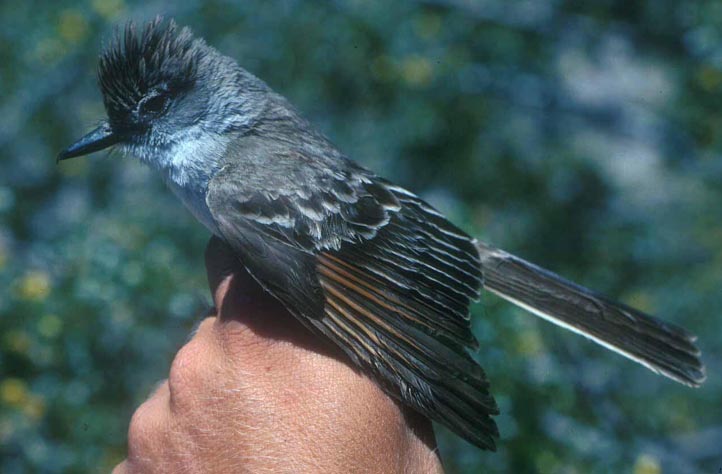 We can also examine the wing in more detail to examine the numbering system
used in the banding literature (e.g., Pyle 1997) and consider other points.
The numbering system is designed to match the way in which most birds conduct
their molt. The primaries ("P" in shorthand) are molted from the inner
ones to the outer ones, and are therefore numbered from the inside out.
The secondaries ("S" in shorthand) are replaced from the outermost to the
innermost, and are therefore numbered from the outside in. Although landbirds
do not have "true" tertials like some waterfowl or other groups, birders
and banders have generally agreed to call the innermost three secondaries
(thus S7, S8, S9) the tertials:
We can also examine the wing in more detail to examine the numbering system
used in the banding literature (e.g., Pyle 1997) and consider other points.
The numbering system is designed to match the way in which most birds conduct
their molt. The primaries ("P" in shorthand) are molted from the inner
ones to the outer ones, and are therefore numbered from the inside out.
The secondaries ("S" in shorthand) are replaced from the outermost to the
innermost, and are therefore numbered from the outside in. Although landbirds
do not have "true" tertials like some waterfowl or other groups, birders
and banders have generally agreed to call the innermost three secondaries
(thus S7, S8, S9) the tertials:
| I have attempted to number the remiges. I believe that the secondaries
are correctly numbered, but am less sure about the primaries. You see there
is a gap between what I have numbered P3 and P5. It is possible that P4
is missing due to an accident. It is also possible that what I have labeled
as "P5" is actually P4, and, if so, then all the numbers larger than that
are off by one. It is also possible that the feather labeled P10 is actually
the base of P9, and that P10 is entirely hidden below it. P10 — the outermost
primary — is considerably shorter than adjacent primaries.
For fun, I used the PhotoShop color picker for the colors of the numbers.
The P numbers are matched to the color of the edges of the inner primaries.
The S numbers are matched to the color of the tertial edges. Recalling
the "three panel" system described on the introductory page, you can see
that the pattern is "red-white-white" (i.e., rufous edges to primaries,
white edges to S1-S4, and white edges to S5-S9).
Note yet something else: the edges of the outer primaries (e.g., P6-P8)
look more orange and less deep rufous than the inner primaries (e.g., P1-P3).
I think it is fair to attribute this to sun bleaching. Recall this is a
May photo so the edges have been subjected to sun for perhaps 8-10 months.
When the bird is perched (which is most of the time) only the outer primary
edges are in the sun, so they bleach while the inner ones do not. Even
with that amount of sun bleaching, the essentially rufous character of
the color is still there. As the inner ones did not bleach, the stark contrast
between deep rufous on P1 — even in an old feather — and the white edging
to S1, is quite obvious. |
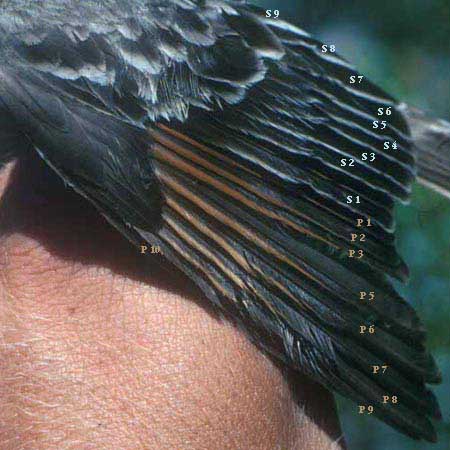 |
Let us now look at the two Nutting's we are using for reference. Below
left is the southern California bird in a fine shot © Larry Sansone;
to the right is another Ed Harper shot of the Arizona bird.
Undoubtedly the most important paper on the Nutting's vs. Ash-throated
problem is Lanyon (1961). He reviewed 485 specimens of Ash-throated, and
229 of Nutting's, all adults in fresh plumage (Sep-Feb) to develop his
plumage keys. In my view, this research is much more important than anecdotal
evidence reported by some about their experiences with a handful (and sometimes
just one or two) birds. As to the wing-panel, Lanyon wrote that Ash-throated
"M. cinerascens has the fringed leading edges of the secondaries
whiter than those of M nuttingi. In M. cinerascens, the deep
rufous edging characteristic of the primaries is never present on
the secondaries (the first secondary may be edged with a very pale rufous)
and the remaining secondaries and tertials are edged with white or grayish
white. In M. nuttingi the deep rufous edging of the primaries
is always present on at least the first secondary and then
fades to a pale rufous or brownish white on the remaining secondaries —
only the tertials are white or grayish white" [emphasis added].
There is one very important caveat: "In using this character, one must
be careful to recognize those specimens of M. cinerascens that are
still
in the process of postjuvenal molt, for the secondaries of the juvenal
plumage of that species are edged with pale rufous and would be confusingly
similar to the condition found in adult M. nuttingi. It is not uncommon
to find specimens collected as late as November and December that still
retain one or two of the juvenal secondaries.... The character can be used
in these specimens, however, for the last secondaries to be replaced are
the inner ones (next to the tertials). Consequently, in molting M. cinerascens,
those
secondaries located adjacent to the primaries will have the white edges
typical of adults" (emphasis added).
| Having learned how to separate the two species on wing-panel characters
— if we can correctly age the bird to exclude juvenal outer secondaries
— let's look at the Santa Cruz bird using a portion of a great Kevin McKereghan
digital photo through a fine scope. To the right is that portion of the
photo and then the same shot with the remiges numbered: |
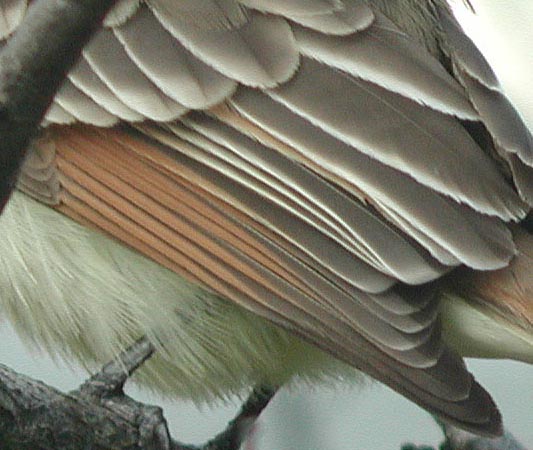 |
| There are many interesting points here. S1 through S4 have fresh clean
edges while S5 (not numbered but just above S4) is obviously worn, and
it is a pale rufous or orange color. This is what Pyle (1997) terms "molt
limits;" S5 is a worn and retained juvenal feather, and ages this bird
as a bird in first-basic plumage, having been born in summer 2002. It was
skipped during the molt as the remaining inner secondaries are fresh. Because
the juvenal secondaries are replaced from the outside in, S1 through S4
are fresh basic secondaries having the characteristics of adult feathers.
I see that S1, the outermost secondary, is very broadly edged rufous, and
that the color is almost identical to the deep rufous of the primary edges.
S 2 is paler, but still has much orange at its base, and then S3 and S4
are paler still. |
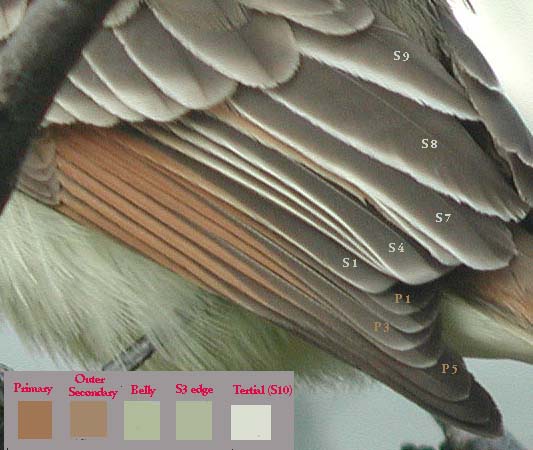 |
Some who have reviewed this photo on Joe Morlan's web site state that the
color of the edges of S2 (excluded the orangey base) through S4 is whitish,
and thus better for Ash-throated. This is an opinion different from most
who studied this feature in the field, often with high-powered scopes.
Most of us saw a pale-yellow (called "cream" by some people) color to these
edges. So I have also done another test on this last photo. Using the PhotoShop
color picker at the half-way point of individual feathers and in the center
of the colorful edge, I have filled five boxes with the colors that the
computer found there. The left hand box is the color found in the edge
of P1, the innermost primary. The next box has the color found mid-way
out on S1, the outer secondary. You can judge for yourself whether this
color is a deep rufous color similar to the primaries — as Lanyon (1961)
says is diagnostic of Nutting's — or a whitish or, at most, "very pale
rufous," which is diagnostic of Ash-throated (now that we know these are
not juvenal feathers). The center box is the color of the belly as shown
in this photograph. [Incidentally, for fun I also used that color to number
the secondaries so you could see how it looked next to the dark color of
the rest of the feather.] The box after that is the color of the edge of
S3. You can judge for yourself whether that color is similar to the color
of the belly. If it is, and you call the belly "yellow," then, a priori,
the edge of S3 is also in the "yellow" category. The final box is filled
with the color of the edge of S10, the uppermost tertial. This is a color
I call "cream" but whatever the exact language, it is clearly in the white
to whitish category.
I have four more thoughts for you to consider about the colors of the
remige edges:
-
Some have stated that they expect the secondaries of Nutting's Flycatcher
to be rufous (like the primaries) rather than orangey or yellow. This is
contrary to Lanyon's study. However, for what its worth, Howell & Webb
(1994) state that southern populations of Nutting's are more richly colored
on the wing panel and belly than northern populations. The only specimen
collected in the U.S. was of the northern subspecies, M. n. inquietus
(Dickerman & Phillips 1953). It is possible that those who rely on
field experience with the southern nominate race (s. Mexico to Costa Rica)
may be comparing apples to oranges (pun intended).
-
Whether or not you agree that the color of S3 (and most of S2 and S4) is
the color of the belly, i.e., in the "yellow" category, it does look less
yellow than on the photos of the Arizona and southern California birds,
where I "see" actual lemon-yellow without the aid of computerized technology.
One possible reason is that, however crisp and wonderful this digital photo
may be, is has washed out the yellows. We can tell that because the belly
is less yellow than on most of the other photos of this bird and much paler
than described in the field. I think it is possible that digital photography
may be great for showing fine details with clarity, but may be less accurate
in capturing exact colors. I will show another possible example of this
on the Plumage page when we compare digital photos — both taken with digital
cameras held up to scopes — of the head colors. McKereghan's set-up (an
Olympus 3030 digital camera with a Leica APO 77 scope with 30-60X eyepiece"
is different than Tom Grey's set up (an Olympus 550 digital camera with
a Nikon Fieldscope 60 ED). I think the Leica gives a "cool" cast to the
photos while the Nikon brings a "warm" cast, even accounting for differences
in natural lighting (or maybe those differences are inherent in the cameras?).
There are some who have conducted an entire review off this single McKereghan
photo but, excellent as it is, it may be unwise to limit one's opinion
to one photo.
-
The other thought is derived from Lanyon's (1961) statement about the value
of the secondary pattern: "The second character [wing panel] is the most
transitory and is of no use in specimens taken after November." Why did
he say this? Obviously, it was because the characters were "transitory"
or, more directly. subject to fading. You will recall that in studying
the Ash-throated Flycatcher (above), we found that the depth of the rufous
color of the outermost primaries had faded somewhat by May. Thus when Lanyon
speaks of the secondary pattern as "the deep rufous edging of the primaries
is always present on at least the first secondary and then fades to a pale
rufous or brownish white on the remaining secondaries — only the tertials
are white or grayish white," we would expect that color to fade as the
months after November go by. All the photos on this page (except Ash-throated)
are from early January, just a month to six weeks after the end of November.
So only partial fading has occurred. I would expect the "pale rufous" to
fade to yellow within a couple months, and the "brownish-white" to fade
to even a paler whitish color. If this hypothesis is correct, the "yellow
mid-panel" that I have discussed so much up to this point is also transitory,
and may be only a useful feature from, say, December through February.
-
Finally, the nice yellow "mid-panel" pattern shown by the Arizona and southern
California birds are on birds we have aged as adults. Perhaps first-winter
Myiarchus
average paler-edged secondaries than adults. It is not unusual for first-year
birds to average paler than adults in some features. I am unaware of any
literature than addresses this point.
PRIMARY PROJECTION
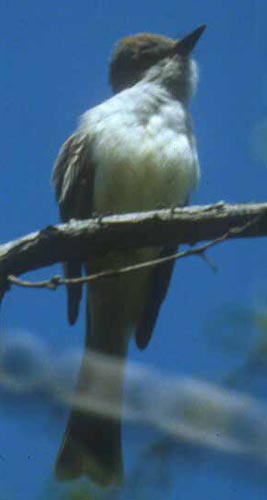 Although
it is not addressed in the literature, it was suggested during the discussions
of the Arizona bird that Nutting's had a shorter primary projection (the
number of primaries sticking out beyond the longest tertial on a closed
wing) than Ash-throated Flycatcher. It was proposed that Nutting's typically
shows only 3 primaries so projecting, while Ash-throated has four or more.
Pyle (1997) notes that Ash-throated has a more pointed (=longer looking)
less rounded wing than Nutting's. On this April photo of an Ash-throated
from Morongo Valley (right; © D. Roberson), we can't count the primaries
but we can get a bit of the "long-winged" feeling that such a wing shape
would present.
Although
it is not addressed in the literature, it was suggested during the discussions
of the Arizona bird that Nutting's had a shorter primary projection (the
number of primaries sticking out beyond the longest tertial on a closed
wing) than Ash-throated Flycatcher. It was proposed that Nutting's typically
shows only 3 primaries so projecting, while Ash-throated has four or more.
Pyle (1997) notes that Ash-throated has a more pointed (=longer looking)
less rounded wing than Nutting's. On this April photo of an Ash-throated
from Morongo Valley (right; © D. Roberson), we can't count the primaries
but we can get a bit of the "long-winged" feeling that such a wing shape
would present.
Go back to the photo at the top of this page and in your "mind's eye"
fold up the wing. S8 is the longest tertial, and I can see that obviously
that the tips of four primaries, numbers P5 through P8 on this page (whose
numbering may be off by one, as discussed above), would well extend beyond
S8 (and any other secondary), and possibly one or two more tips would also
stick out. On Larry Sansone's very nice shot of the Orange County bird,
it is apparent that only 3 primary tips are projecting. We can't see details
of the Arizona bird, but the primary projection is short, and is consistent
with the Orange County bird's shape.
On the Santa Cruz bird, using the photo above and folding it up, it
looks to me that only three primary tips (numbered 5, 6, and 7 in the photo)
would extend beyond the longest tertial (S8). Assuming the numbers are
correct, P8 — usually the longest primary in many flycatchers — is hidden
under P7 and must be essentially the same length, with P9 somewhat shorter.
This would be a rounded wing and is consistent with Pyle's (1997) details
on Nutting's, who explains that P9 is just barely longer than P5 (by 1-3
mm) in Nutting's, but that P9 is quite a bit longer (3-7 mm) than P5 in
Ash-throated. If you look at the Ash-throated at the top, and if the numbering
is correct, P9 does look a fair bit longer than P5, consistent with a 3-7mm
difference. However, since we can't actually see all the outer primaries,
these points are conjecture. You may judge what weight to place on them.
The other pages in this project are:
LITERATURE CITED:
-
Bowers, R.K., Jr., and J.B. Dunning, Jr. 1987. Nutting's Flycatcher (Myiarchus
nuttingi) from Arizona. Amer. Birds 41:5-10.
-
Cardiff, S.W., and D.L. Dittmann. 2000. Brown-crested Flycatcher (Myiarchus
tyrannulus) in The Birds of North America, No. 496 (A. Poole
and F. Gill, eds.). The Birds of North America, Inc., Philadelphia, PA.
-
Cardiff, S.W., and D.L. Dittmann. 2002. Ash-throated Flycatcher (Myiarchus
cinerascens) in The Birds of North America, No. 664 (A. Poole
and F. Gill, eds.). The Birds of North America, Inc., Philadelphia, PA.
-
Devillers, P. 1971. The alleged occurrence of Nutting's Flycatcher in Baja
California. Calif. Birds 2:140.
-
Dickerman, R.W., and A.R. Phillips. 1953. First United States record of
Myiarchus nuttingi. Condor 55:101-102.
-
Dittmann, D.L., and S.W. Cardiff. 2000. Let's take another look: Myiarchus
flycatchers. LOS News 193:3-10. Louisiana Ornithol. Society, Baton Rouge.
-
Howell, S.N.G., and S. Webb. 1994. Field identification of Myiarchus
flycatchers in Mexico. Cotinga 2:20-25.
-
Howell, S.N.G., and S. Webb. 1995. A Guide to the Birds of Mexico and northern
Central America. Oxford Univ. Press, New York.
-
Lanyon, W.E. 1961. Specific limits and distribution of Ash-throated and
Nutting flycatchers. Condor 63:421-449.
-
Lanyon, W.E. 1997. Great Crested Flycatcher (Myiarchus crinitus)
in
The Birds of North America, No. 300 (A. Poole and F. Gill, eds.). The Birds
of North America, Inc., Philadelphia, PA.
-
Murphy, W.L. 1982. The Ash-throated Flycatcher in the East: an overview.
Amer. Birds 36:241-247.
-
National Geographic Society. 1999. Field Guide to the Birds of North America,
3rd ed. Nat. Geogr. Soc., Washington, D.C.
-
Phillips, A.R., and W.E. Lanyon. 1970. Additional notes on the flycatchers
of eastern North America. Bird-Banding 41:190-197.
-
Pyle, P. 1997. Identification Guide to North American Birds, Part I: Columbidae
to Ploceidae. Slate Creek Press, Bolinas, CA.
-
Zimmerman, D.A. 1978. A probable Nutting's Flycatcher in southwestern New
Mexico. West. Birds 9:135-136.
TOP
GO TO MONTEREY
COUNTY PAGE
GO TO HOME PAGE
GO TO
IDENTIFICATION PAGE
GO TO BIRDING THE
WORLD PAGE
GO TO BIRD FAMILIES
OF THE WORLD
Page created 23-24 Jan 2003



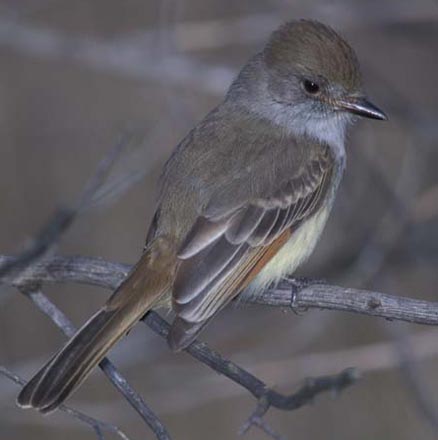
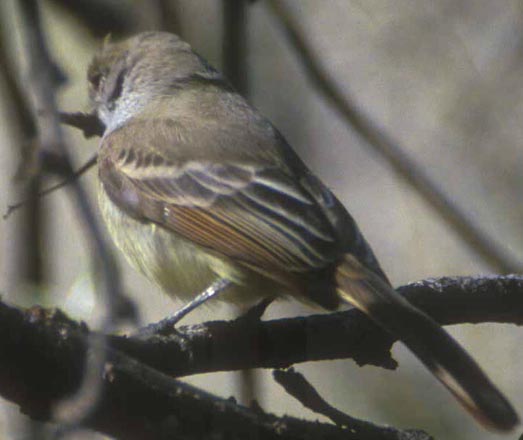
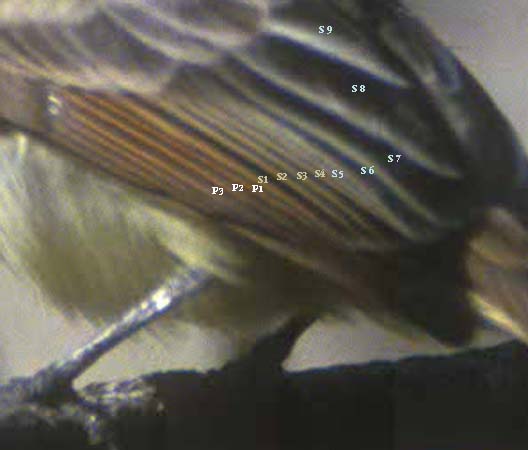


 Although
it is not addressed in the literature, it was suggested during the discussions
of the Arizona bird that Nutting's had a shorter primary projection (the
number of primaries sticking out beyond the longest tertial on a closed
wing) than Ash-throated Flycatcher. It was proposed that Nutting's typically
shows only 3 primaries so projecting, while Ash-throated has four or more.
Pyle (1997) notes that Ash-throated has a more pointed (=longer looking)
less rounded wing than Nutting's. On this April photo of an Ash-throated
from Morongo Valley (right; © D. Roberson), we can't count the primaries
but we can get a bit of the "long-winged" feeling that such a wing shape
would present.
Although
it is not addressed in the literature, it was suggested during the discussions
of the Arizona bird that Nutting's had a shorter primary projection (the
number of primaries sticking out beyond the longest tertial on a closed
wing) than Ash-throated Flycatcher. It was proposed that Nutting's typically
shows only 3 primaries so projecting, while Ash-throated has four or more.
Pyle (1997) notes that Ash-throated has a more pointed (=longer looking)
less rounded wing than Nutting's. On this April photo of an Ash-throated
from Morongo Valley (right; © D. Roberson), we can't count the primaries
but we can get a bit of the "long-winged" feeling that such a wing shape
would present.